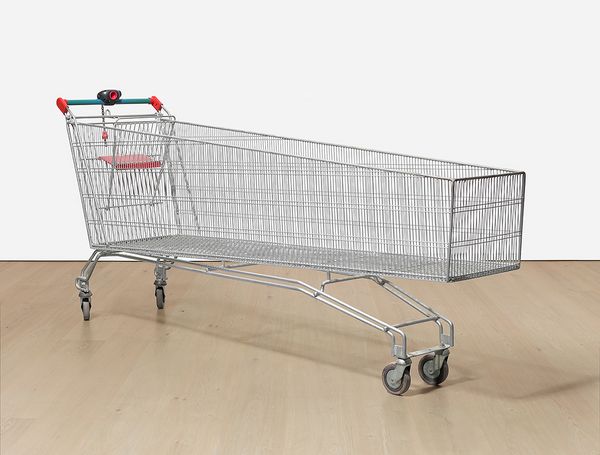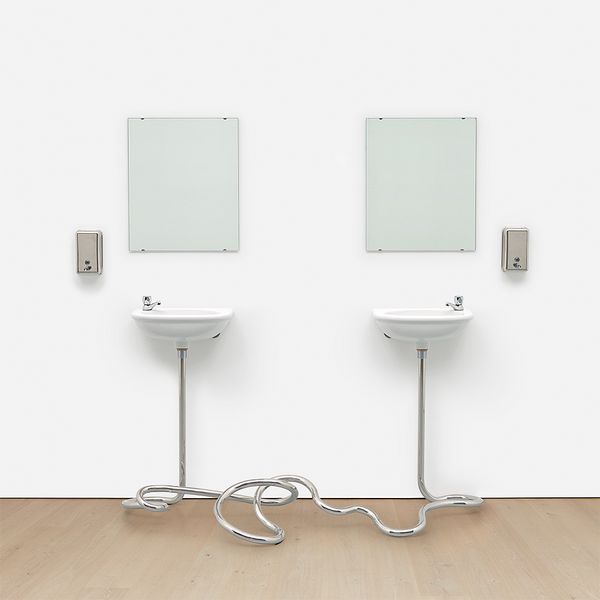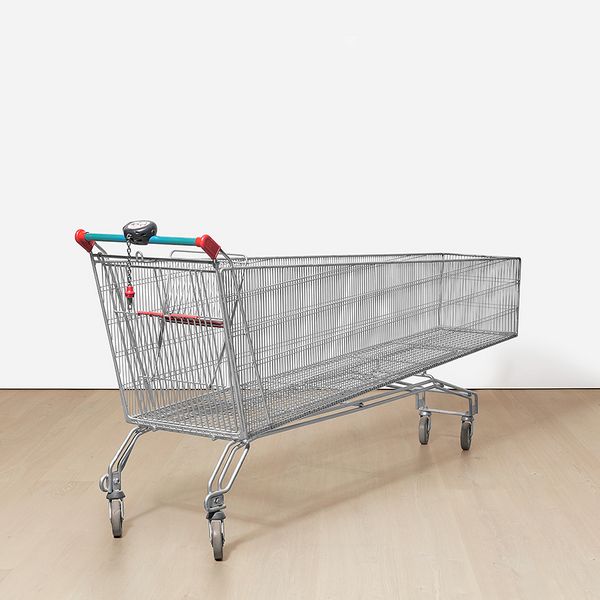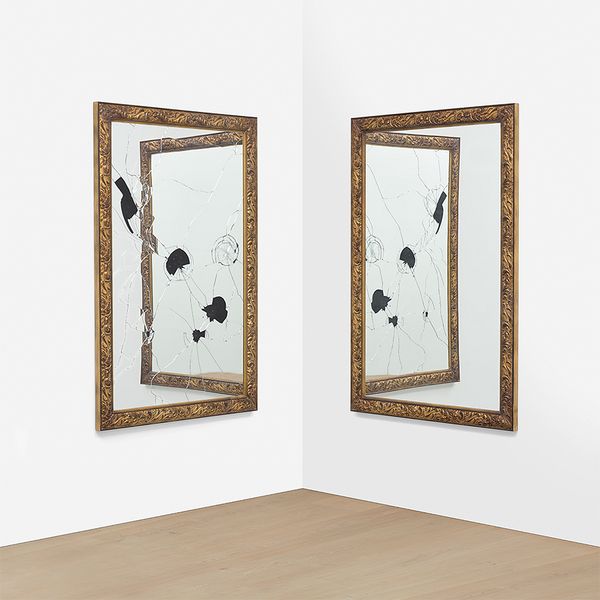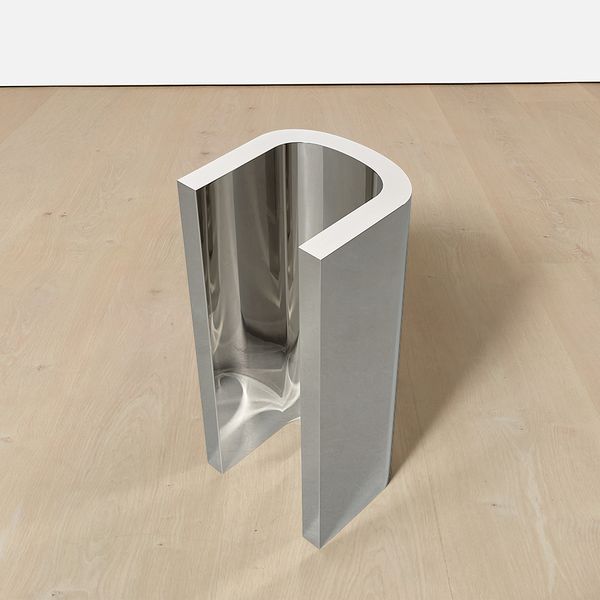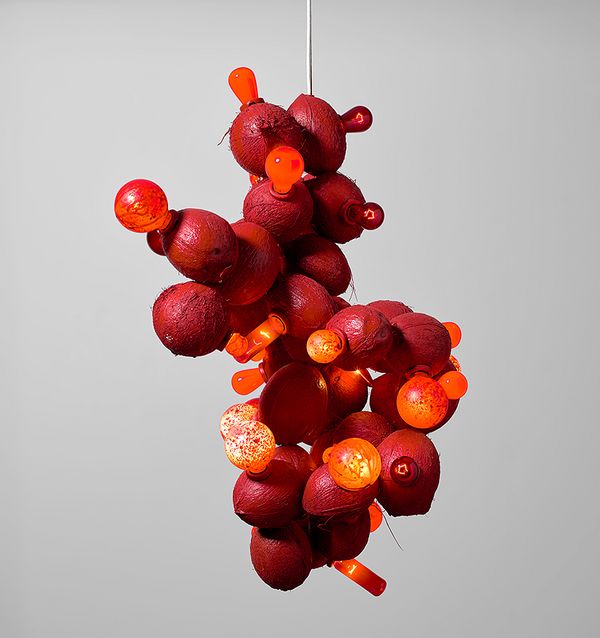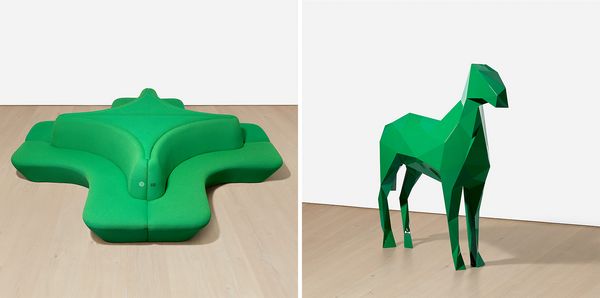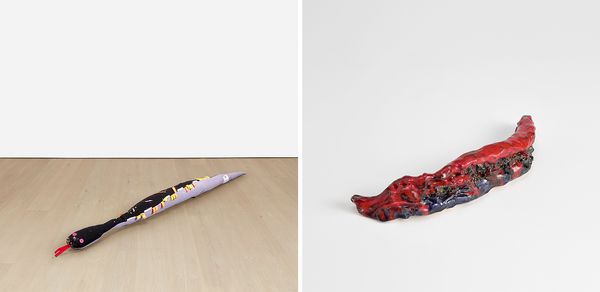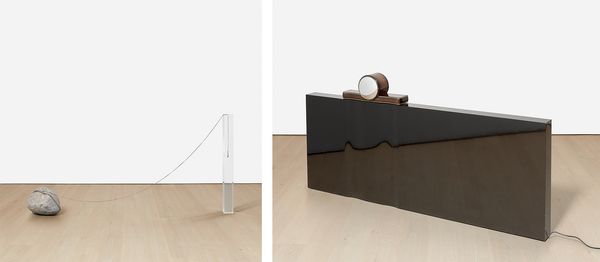Maurizio Cattelan, Less than ten items, 1997. New Now: Modern & Contemporary Art, London.
There’s an inherent fluidity to an encounter with three-dimensional works, and even more so when they’re of great scale. Many factors — the space in which the works are placed, the influence of other art or objects that surround them, and our shifting position while viewing them — can alter our understanding of forms, provoking a fluctuating and visceral response. With such works, our gaze is active in a multifaceted process that requires our input. In short, to truly perceive works of this nature we need to share physical space with them.
These aspects of sculpture are among those explored in the lauded exhibition When Forms Come Alive, currently on view at the Hayward Gallery, and the possibility of an extension of many ideas presented by the show exists with several works in our upcoming New Now auction in London. Like the Hayward exhibition, many of these works reveal playful or humorous facets of their nature as they engage with everyday objects to trigger an immediate and joyful sensation that ultimately leads to deeper consideration. Further, the participatory, almost collaborative aspect of viewing sculptural works is heightened in our offering by a few works made by artists who themselves were working in collaboration.
Though viewing sculptural works on a digital screen is gratifying, the pleasures of such works are inherently physical, lifelike, and enchanting. And as with the Hayward exhibition, the viewing at Phillips ahead of the auction invites engagement with the physical world. Below, we highlight several works on view through 19 April in our magnificent gallery space at 30 Berkeley Square that await your encounter.
Elmgreen & Dragset
Elmgreen & Dragset, Second Marriage, 2008. New Now: Modern & Contemporary Art, London.
The provocative conceptual works of Scandinavian artist-duo Michael Elmgreen and Ingar Dragset take ideas we expect to be fixed and unexpectedly prove they can be flexible. Their 2008 work Second Marriage is part of a lineage of works. It essentially takes the scene of 2004’s Marriage and adds soap dispensers, humorously inviting us to question what has changed between the first and second iterations of the idea. Their 2010 work Gay Marriage presents a similar sight but utilizing urinals, with each work calling on an inoperable intertwining of pipes to playfully probe the institution of marriage and the role of sexuality in contemporary society.
Here, by literally bending the functional rules of everyday objects, they offer the possibility for pliability in the face of the more rigid aspects of culture. As Michael Elmgreen told Artspace in 2020, “It’s so important to show that you can break the rules, even on a small scale, especially in societies that have become more and more regulated. If you don’t keep that flame alight, what is there, in the end?”
Maurizio Cattelan
Maurizio Cattelan, Less than ten items, 1997. New Now: Modern & Contemporary Art, London.
Less than ten items is a distorted supermarket shopping cart, extending more than seven feet long, seemingly to allow for the volume of consumption rampant in the developed world. Its placement within a fine art context — either in a gallery space or in an art-filled home — draws parallels between mass consumerism and the collection of cultural objects. Its cheeky title suggests a container for very few, large-scale items, comically just under the requirement for using the express check-out lane. Who else could the artist behind this work be other than the one who made global headlines with a simple idea, a roll of duct tape, and a banana?
Frequently described as the court jester of the art world, Maurizio Cattelan makes works that place themselves squarely within the ongoing oscillation between popular culture and high art, commercial consumerism and cultural production. Along the way, they irreverently reflect a sublimation of the desires instilled in us by both mass-market advertising and the ideals and ideas of contemporary fine art, offering us the power as viewers to consider whose influence we’re under and to reclaim it if we choose. Cattelan knows what will get our attention and makes a fool of us as he captures it, but it’s impossible to not love every minute of it.
Michelangelo Pistoletto
Michelangelo Pistoletto, Two Less One, 2009. New Now: Modern & Contemporary Art, London.
For Michelangelo Pistoletto, the mirror has long been a fruitful device, simultaneously serving as a medium for renewed approaches to self-portraiture, a way to mimic and alter reality, and a tool for extending the eye’s reach. These mirrors were part of the 2016 performance work Eleven Less One at the Kunsten Museum of Modern Art Aalborg. At the performance, the artist crushed 10 of 11 mirrors with a large mallet, explaining in his concluding speech that “the broken pieces of the mirror are an image of society. Everybody is simultaneously an individual and part of a larger whole, and when we make eye contact, we see both ourselves and a projection of the other’s mind.”
Installed at the corner of a wall, the mirrors that comprise Two Less One in a sense “see” both us and each other. What is in reality one space, one person, and two objects, becomes four people, four objects, and four spaces. The subtractive notion of the work’s title can be seen to be represented by the shattered portions of one mirror’s surface, creating an additive contradiction as the imperfections are reproduced and amplified through reflection.
Wade Guyton
Wade Guyton, U Sculpture (V. 5), 2007. New Now: Modern & Contemporary Art, London.
Wade Guyton’s U Sculpture (V. 5) extends the artist’s characteristic exploration of production, reproduction, and mistranslation between the analog and digital worlds. Well-known for creating paintings that result from misfeeding primed canvas through ink-jet printers designed for paper, his iconic imagery is the result of the technology’s failure to correctly reproduce simple keystrokes of X’s and U’s. In the case of this sculpture, the typed letter U is cleanly lengthened, mirror polished, and given dimension, placing it in conversation with the surrounding space and Guyton’s broader work, and contextualizing it within American Minimalist art history through his use of the same fabricators who produced many of Donald Judd’s works — Milgo in Brooklyn, New York.
Kelley Walker and Wade Guyton
Kelley Walker and Wade Guyton, Red Coconut Chandelier, Cablage, 2006. New Now: Modern & Contemporary Art, London.
Each an iconic artist with their own respective practices, when Kelley Walker and Wade Guyton collaborate, their goal is to function as a single independent artist. The pair treat their individual styles and approaches as things than can be incorporated and altered as they see fit. There’s a freedom in how they unpack questions of authorship, production, commodity, and distribution that is immediately identifiable, cheeky, and compelling. The coconut is an everyday organic object often incorporated in their collaborative works, in this case taking the form of an ornate and functional chandelier. Placed in a functional interior context, the organic shapes of the coconut are transformed, appearing as something otherworldly or manufactured rather than naturally grown. This notion plays into their approach as a duo, as Guyton explained in a conversation with Walker published in ARTFORUM, “It’s weird to feel ownership but then also feel as if you’re separate from it — that it’s alien.”
Mike Kelley
Mike Kelley, Lingam and Yoni (Grosse Île), 2002. New Now: Modern & Contemporary Art, London.
In the Lingam and Yoni series, Mike Kelley explores ideas of nature and desire through the Hindu symbol for male and female genitalia. Kelley employs soil and litter from islands on the Detroit River — near where he grew up in Michigan — to construct the works in the series. The works call on this Hindu visual lineage to express his desire to scout these islands, one that he has described as a sexual fantasy. In this work, the large Yoni basin is a vessel for the naturalistic recreation of the Grosse Île’s soil and a base for the phallic Lingam. Ultimately, the work presents an eccentric tangle of associations between eroticism, orientalism, and the conception of home.
Discovering Interplay
Left: Damien Hirst, Pharmacy Cross Banquette, 1997–98. Right: Xavier Veilhan, The Horse, 2009. New Now: Modern & Contemporary Art, London.
When encountering sculptural works in a space, we discover that they also encounter each other. Works can find surprising ways to resonate with or connect to each other when skillfully assembled and well-placed in a gallery. Damien Hirst’s Pharmacy Cross Banquette and Xavier Veilhan’s life-sized sculpture The Horse don’t just share a similar hue of striking green, they each explore geometric forms, the play of light and shadow, and subvert the meanings of cultural symbols that typically signify authority — the state-erected equestrian statue and the international symbol of pharmacists.
Right: Franz West, Three works: (i-iii) Onkel-Stuhl (Uncle Chair), 2006. Left: Alex Da Corte, GOBS/A Boxes (White Closet), 2015. New Now: Modern & Contemporary Art, London.
Alex Da Corte’s GOBS/A Boxes (White Closet) and Franz West’s three Uncle Chairs each investigate the relationship between art and object. For West, who is included in the current Hayward exhibition, the question of why furniture was separated from its function when placed in museums was an early fascination. Chairs became a consistent presence in his practice, with the colorful weave here being emblematic of his lauded series of Uncle Chairs. His aim was to create works of art that challenge viewers but also invite them to interact with them. Da Corte draws on a myriad of art historical and cultural connotations in his practice, with the present work reading like a fever dream of American consumerism and entertainment. It makes use of such objects as a plastic bust of David, an animatronic Homer Simpson statue, a Marge Simpson Halloween costume, and various Christmas and Halloween decorations, including an iconic Freddy Krueger candy bowl.
Sterling Ruby, SNAKE (4694), 2013 (left) and Lips (4748), 2014 (right). New Now: Modern & Contemporary Art, London.
Interplay between works can be experienced both within the work of one artist and across multiple — even when their works at first seem very different. The works of Sterling Ruby and Alicja Kwade stand in contrast to each other aesthetically, but each seeks new means of understanding fundamental questions of existence through a free engagement with everyday objects, natural materials, historical and art historical symbols, and much else. It’s these personal and unexpected discoveries of interplay that can make encountering sculptures particularly unique, and many such discoveries await you this month at Phillips London.
Alicja Kwade, Heavy times (3pm), 2014 (left) and Raum - Zeit - Krümmung 2, 2009 (right). New Now: Modern & Contemporary Art, London.
Discover More from Modern & Contemporary Art >
Recommended Reading
